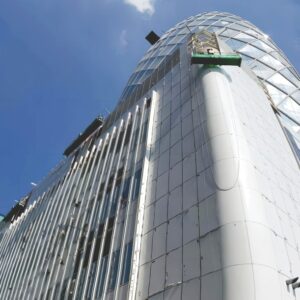I. Introduction
A. Hook
In the construction of the iconic Burj Khalifa, the gleaming aluminum sheets that adorn its exterior not only contribute to its stunning aesthetic appeal but also play a crucial role in its structural integrity. These aluminum sheets, sourced from a specific brand, were chosen for their unique combination of quality, performance, and durability. However, one might wonder, how much would the price of these sheets vary if a different brand had been selected? This leads us to the fascinating world of aluminum sheet prices and the significant differences that exist among various brands.
B. Thesis Statement
This article aims to comprehensively explore and explain the substantial price differences among different brands of aluminum sheets. We will delve into the factors that influence these price disparities, including raw material quality, manufacturing processes, brand reputation, and market demand. By understanding these elements, consumers and industry professionals can make more informed decisions when choosing the right aluminum sheets for their specific applications.
II. Understanding the Basics of Aluminum Sheets

A. Definition and Composition
Aluminum sheets are flat, thin pieces of aluminum metal that are widely used in various industries. They are typically made from pure aluminum or aluminum alloys. Pure aluminum offers excellent corrosion resistance and conductivity, while alloys are formulated by adding other elements to enhance specific properties. Common alloying elements include copper, which improves strength and hardness; magnesium, which increases strength and ductility; manganese, which enhances strength and wear resistance; silicon, which boosts fluidity during casting and improves heat resistance; and zinc, which contributes to strength and corrosion resistance. The combination and proportion of these alloying elements can significantly impact the performance and price of the aluminum sheets.
B. Common Applications
Aluminum sheets find extensive use in numerous industries due to their desirable properties. In the construction industry, they are used for building facades, roofing, wall panels, doors, and windows. Their lightweight nature makes them easy to handle and install, while their corrosion resistance ensures durability in various weather conditions. In the automotive sector, aluminum sheets are employed for body panels, engine components, and frames. This helps reduce the overall weight of the vehicle, leading to improved fuel efficiency and performance. The aerospace industry relies heavily on aluminum sheets for aircraft skins, wings, and other structural parts, where their high strength-to-weight ratio is crucial. Additionally, aluminum sheets are used in the packaging industry for food and beverage cans, foil, and other containers, thanks to their non-toxic and corrosion-resistant properties. They also have applications in the electronics and electrical appliances industry for heat sinks, casings, and connectors, as well as in the manufacturing of household goods such as kitchen utensils and furniture.
III. Factors Influencing the Price of Aluminum Sheets

A. Quality Differences
1. Material Purity
The purity of aluminum is a crucial factor in determining its quality and price. High-purity aluminum, typically 99% or above, offers superior corrosion resistance and conductivity. For example, in the electronics industry, where these properties are vital, aluminum with a purity of 99.99% is often used for components like heat sinks and connectors. This high-purity aluminum commands a premium price due to its enhanced performance characteristics. On the other hand, lower purity aluminum, which may contain impurities such as iron, silicon, and copper, is more suitable for applications where cost is a primary concern, such as some construction and packaging applications. The presence of impurities can affect the material’s ductility, strength, and corrosion resistance, leading to a lower price point.
2. Surface Quality
The surface finish of aluminum sheets is another significant aspect. A smooth, defect-free surface is not only aesthetically pleasing but also indicates better quality. Aluminum sheets with a high-quality surface finish, free from scratches, pits, and blemishes, are more desirable in applications such as architectural facades and automotive body panels. The process of achieving a superior surface finish, which may involve techniques like polishing, anodizing, or coating, adds to the production cost and subsequently the price of the sheets. In contrast, aluminum sheets with a rougher or less refined surface are typically used in less demanding applications where appearance and surface quality are not critical, and thus they are available at a lower price.
3. Mechanical Properties
Mechanical properties such as hardness, tensile strength, and elongation vary among different grades of aluminum sheets and have a direct impact on price. For instance, aluminum alloys with higher copper content, like the 2000 series, exhibit increased strength and hardness, making them suitable for aerospace and high-stress applications. These alloys are more expensive due to their enhanced mechanical performance. In contrast, the 1000 series of pure aluminum, which has relatively lower strength but excellent formability, is used in applications where ease of shaping is more important than high strength, such as in some food packaging and decorative items. The difference in mechanical properties is a result of the alloy composition and manufacturing process, which in turn dictates the price range of the aluminum sheets.
B. Production Process
1. Manufacturing Technology
The choice of manufacturing technology significantly affects the cost and price of aluminum sheets. Traditional manufacturing methods, such as casting and hot rolling, have been widely used for decades. Casting involves pouring molten aluminum into molds to form the desired shape, while hot rolling is used to reduce the thickness and improve the mechanical properties of the sheets. These methods are relatively cost-effective for large-scale production of standard aluminum sheets. However, advanced manufacturing technologies like cold rolling, extrusion, and powder metallurgy offer certain advantages. Cold rolling, for example, can produce sheets with a smoother surface finish and tighter tolerances, but it requires more energy and is more expensive. Extrusion is used to create complex shapes and profiles, which are often used in the construction and automotive industries, but the tooling and production costs are higher compared to traditional methods. Powder metallurgy allows for the production of high-performance alloys with unique properties, but it is a more complex and costly process. The adoption of these advanced technologies generally leads to an increase in the price of the aluminum sheets.
2. Processing Complexity
Additional processing steps further contribute to the cost of aluminum sheets. Processes such as bending, punching, welding, and surface treatments like painting, anodizing, and powder coating add value but also increase the price. For example, aluminum sheets that require precise bending and forming to meet specific design requirements, such as those used in custom-made furniture or high-end architectural components, will cost more due to the added labor and expertise involved. Similarly, surface treatments not only enhance the appearance but also improve the corrosion resistance and durability of the sheets. However, these treatments involve the use of chemicals, energy, and specialized equipment, all of which add to the overall cost. The more complex the processing requirements, the higher the price of the aluminum sheets.
C. Market Supply and Demand
1. Global Market Trends
The global aluminum market is influenced by various factors that impact the supply and demand dynamics and, consequently, the price of aluminum sheets. In recent years, the increasing demand for aluminum in emerging economies, particularly in the construction and automotive sectors, has driven up the overall consumption. As countries invest in infrastructure development and the automotive industry shifts towards lightweight materials to improve fuel efficiency, the demand for aluminum sheets has surged. On the supply side, factors such as the availability of bauxite ore, the primary raw material for aluminum production, and the production capacity of aluminum smelters play a crucial role. Disruptions in the supply chain, such as mine closures, labor strikes, or natural disasters affecting production facilities, can lead to a decrease in supply and an increase in prices. Additionally, global economic conditions, trade policies, and technological advancements in the aluminum industry also contribute to the market trends and price fluctuations.
2. Seasonal and Regional Variations
Seasonal and regional factors can cause significant variations in the demand for aluminum sheets, leading to price fluctuations. In the construction industry, for example, the demand for aluminum sheets is typically higher during the spring and summer months when construction activities are at their peak. This increased demand can lead to a temporary rise in prices. Regionally, areas with a booming construction or manufacturing sector, such as certain metropolitan areas or industrial regions, may experience higher demand and prices compared to regions with less economic activity. Moreover, factors like climate can also influence the demand for aluminum sheets. In regions with harsh weather conditions, such as coastal areas with high humidity and salt exposure or areas with extreme temperatures, there may be a greater demand for aluminum sheets with enhanced corrosion resistance and thermal properties, which can affect the price based on the specific requirements and availability of such specialized sheets.
D. Brand Value and Reputation
1. Brand Awareness and Perception
Well-known brands with a good reputation in the market often command a higher price for their aluminum sheets. Brands that have been in the industry for a long time and have established a track record of providing high-quality products are perceived as more reliable by customers. For example, some leading international brands are associated with consistent quality, advanced manufacturing processes, and strict quality control standards. Customers are willing to pay a premium for these brands because they trust the product’s performance and durability. The brand’s image and reputation are built over time through factors such as product innovation, customer service, and marketing efforts. A positive brand perception not only justifies a higher price but also creates customer loyalty, which further strengthens the brand’s position in the market.
2. After-Sales Service and Support
The quality of after-sales service and support provided by a brand also contributes to its value and the price of its products. Brands that offer warranties, technical assistance, and prompt customer service in case of any issues or defects are more attractive to customers. A comprehensive warranty gives customers peace of mind and indicates the brand’s confidence in its product quality. Technical support, such as providing guidance on installation, maintenance, and troubleshooting, can add significant value, especially for customers who are using the aluminum sheets in complex applications. Brands that invest in building a strong after-sales service network and providing excellent support are able to justify a higher price for their aluminum sheets compared to those that offer limited or no after-sales services.
IV. Comparison of Prices among Different Brands
A. Case Studies of Popular Brands
1. Brand A
Brand A is a well-established name in the aluminum sheet industry, renowned for its high-quality products. Their aluminum sheets are made from a carefully selected alloy blend, with a high percentage of pure aluminum and precisely controlled alloying elements. This results in excellent corrosion resistance, making it a popular choice for outdoor applications such as building facades and roofing. For example, in a recent high-rise building construction project in a coastal city, Brand A’s aluminum sheets were used for the exterior cladding. The sheets not only withstood the harsh saltwater environment but also maintained their aesthetic appeal over time. The surface finish of Brand A’s sheets is achieved through an advanced anodizing process, which gives them a smooth and durable appearance. Customers have praised the brand for its consistent quality and reliable performance. In terms of price, Brand A’s aluminum sheets are at the upper end of the spectrum. A standard 3mm thick sheet in a common size might cost around $5 per square foot, depending on the quantity and specific alloy grade.
2. Brand B
Brand B has positioned itself as a more cost-effective alternative to some of the premium brands. Their aluminum sheets are manufactured using a slightly different alloy composition, which allows them to offer a competitive price point. While the quality of Brand B’s sheets is still acceptable for many applications, they may not have the same level of corrosion resistance or surface finish as Brand A. For instance, in a mid-sized commercial building project, Brand B’s sheets were used for interior partitions. The sheets were easy to work with and provided a satisfactory appearance for the intended application. However, in a long-term durability test, they showed some signs of oxidation in a humid environment compared to Brand A. Brand B’s prices are significantly lower, with a similar 3mm thick sheet costing around $3 per square foot. This makes it an attractive option for budget-conscious customers who are willing to compromise slightly on quality for a better price.
3. Brand C
Brand C is a relatively new player in the market that has gained attention for its innovative manufacturing process. They use a proprietary cold rolling technique that results in aluminum sheets with enhanced mechanical properties, such as higher tensile strength. This makes their sheets suitable for applications where strength is a critical factor, like in the automotive and machinery industries. In a recent automotive manufacturing project, Brand C’s aluminum sheets were used for engine components, reducing the overall weight of the engine while maintaining its structural integrity. The brand has also invested in marketing its environmentally friendly production methods, which has appealed to some customers. In terms of price, Brand C’s sheets are priced competitively with Brand A for their high-performance grades. A 4mm thick sheet with the enhanced mechanical properties might cost around $6 per square foot, reflecting the added value of their unique manufacturing process.
B. Price Range Analysis
The following table provides a detailed price range comparison for different brands and grades of aluminum sheets:
| Brand | Alloy Grade | Thickness (mm) | Price Range per Square Foot ($) |
| Brand A | 5052 | 2 | 4 – 5.5 |
| Brand A | 6061 | 3 | 5 – 6.5 |
| Brand A | 3003 | 4 | 4.5 – 6 |
| Brand B | 5052 | 2 | 2.5 – 3.5 |
| Brand B | 6061 | 3 | 3 – 4 |
| Brand B | 3003 | 4 | 2.8 – 3.8 |
| Brand C | 5052 (Enhanced) | 2 | 4.5 – 6 |
| Brand C | 6061 (Enhanced) | 3 | 5.5 – 7 |
| Brand C | 3003 | 4 | 4 – 5.5 |
The price variations can be attributed to several factors. The higher-priced brands like Brand A and Brand C (for their enhanced grades) often invest more in research and development to improve their manufacturing processes and product quality. They also have stricter quality control measures in place, which adds to the production cost. Brand reputation and customer perception also play a role, as customers are often willing to pay a premium for a brand they trust. On the other hand, Brand B’s lower prices are a result of its focus on cost-effective production methods and targeting the price-sensitive market segment. Additionally, the availability of raw materials and economies of scale in production can also impact the price differences among brands. Larger brands with more efficient supply chains and higher production volumes may be able to offer slightly lower prices for standard grades, while smaller or specialized brands may charge more for their unique products.
V. Making the Right Choice
A. Balancing Price and Quality
When it comes to choosing the right aluminum sheets, consumers and businesses must carefully consider their specific needs and priorities. For applications where performance and durability are critical, such as in aerospace or high-end architectural projects, it may be worth investing in a higher-priced brand with a proven track record of quality. These brands often offer superior material purity, better surface finishes, and enhanced mechanical properties, which can ensure the long-term success of the project. However, for less demanding applications, such as some interior decoration or temporary structures, a more budget-friendly option may be sufficient. In such cases, it is important to evaluate the trade-offs between price and quality and select a brand that offers the best value for money. One way to do this is to compare the specifications and performance characteristics of different brands and grades of aluminum sheets, and also to seek advice from industry experts or experienced contractors. Additionally, considering the long-term costs, including maintenance and replacement, can help in making a more informed decision. For example, a slightly higher initial investment in a better-quality aluminum sheet may result in lower maintenance costs and a longer lifespan, ultimately providing better overall value.
B. Consideration of Application Requirements
The intended application of the aluminum sheet should be the primary guide in choosing the appropriate brand and grade. In the construction industry, for building facades in a coastal area with high humidity and salt exposure, an aluminum sheet with excellent corrosion resistance, such as those from Brand A, would be a suitable choice. The additional cost of the higher-quality sheet is justified by its ability to withstand the harsh environmental conditions and maintain its appearance and structural integrity over time. In the automotive industry, where weight reduction and strength are crucial, a brand like Brand C that offers enhanced mechanical properties through its innovative manufacturing process might be preferred for engine components or body panels. For the packaging industry, where cost is often a major factor and the requirements for mechanical strength and corrosion resistance are relatively lower, a more economical brand with acceptable quality, like Brand B, could be a viable option for food and beverage cans or foil. Different industries have varying demands in terms of strength, formability, corrosion resistance, and appearance, and understanding these specific requirements is essential for making the right choice. By matching the application needs with the appropriate aluminum sheet brand and grade, both performance and cost-effectiveness can be achieved.
VI. Conclusion
A. Summary of Key Points
In conclusion, the price differences among aluminum sheet brands are substantial and are influenced by multiple factors. Quality differences, including material purity, surface quality, and mechanical properties, play a significant role. The production process, such as the choice of manufacturing technology and processing complexity, also impacts costs and prices. Market supply and demand dynamics, both globally and seasonally/regionally, lead to price fluctuations. Brand value and reputation, in terms of brand awareness, perception, and after-sales service, contribute to the price disparity. By understanding these factors, consumers and industry professionals can make more informed decisions when choosing aluminum sheets, carefully balancing price and quality based on their specific application requirements.
B. Future Outlook
Looking ahead, the aluminum sheet market is likely to continue evolving. As technology advances, we can expect further improvements in manufacturing processes, potentially leading to more cost-effective production methods and potentially narrower price gaps between high-quality and budget brands. However, the demand for aluminum sheets is also expected to grow, especially in emerging economies and industries focused on lightweight and sustainable materials. This could put upward pressure on prices, depending on the availability of raw materials and production capacity. Brand competition is likely to intensify, with companies striving to differentiate themselves through innovation, quality, and service. Overall, the market will remain dynamic, and staying informed about the latest trends and developments will be crucial for making optimal decisions in the aluminum sheet market.





